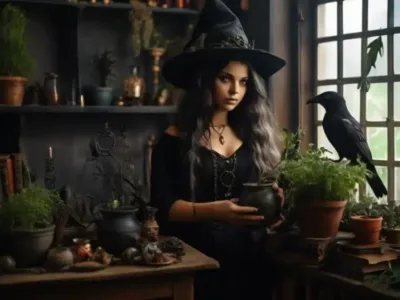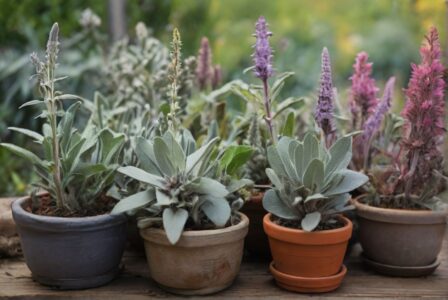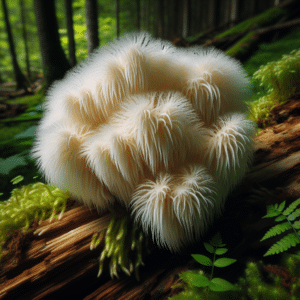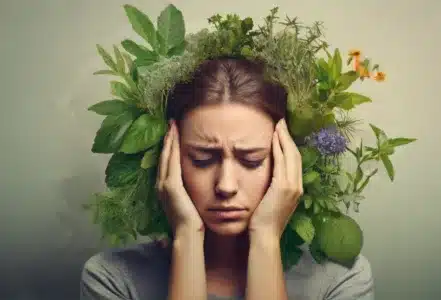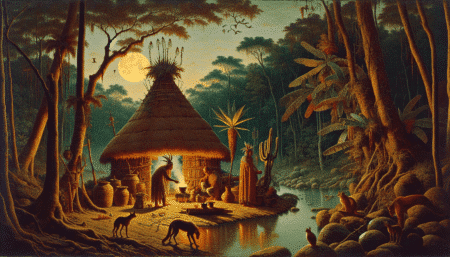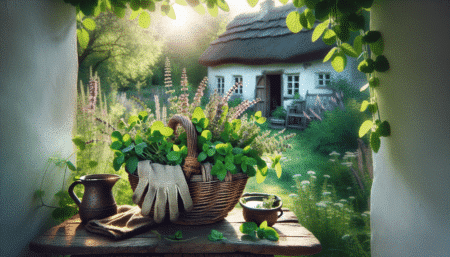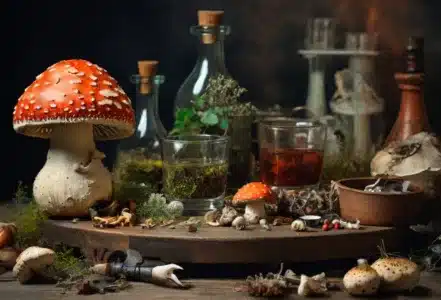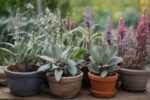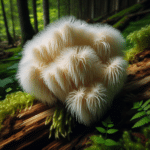- Introduction: The fascinating world of witchcraft herbs
- What are witchcraft herbs and what role do they play in the story?
- Mandrake - the root with magical powers
- Magic thistle - a versatile herb for love spells and healing
- Moonlight flower - the mysterious plant for potions and rituals
- Witch's herb of death: Belladonna as dangerous poison or healing medicine?
- Mugwort - the popular herb for protective spells and cleansing incenses
- The secret of vervain: from driving away evil spirits to relieving headaches
- Sage - more than just a kitchen plant, also very popular with witches!
- Conclusion: Immerse yourself in the magical world of witchcraft herbs!
You can find our mandrake seeds here!
Here you can find our mugwort seeds!
Here you can find our witchweed seeds!
Here you can find our different sage seeds!
You think you know all the magical herbs? But have you ever heard of the mysterious witchcraft herbs? In this blog you will discover a world full of old articles, exotic spices and enchanting liqueurs. Whether from China, Japan or Germany - here you will find everything about herbal blends, spirits and delicious fruit teas. So grab a cup, sit back and immerse yourself in the fabulous witches' herbs mail order service!
1. introduction: The fascinating world of witchcraft herbs
Are you curious about the fascinating world of witchcraft herbs? Then buckle up, because together we're going to immerse ourselves in a magical garden full of surprises. From ancient herbal blends from China to exotic spices from Japan - there are no limits to the adventure here! Are you ready to unleash your senses in this enchanted realm of flavors and spirits? Let's get started and find out what makes these witchy herbs so special!
2 What are witchcraft herbs and what role do they play in the story?
Imagine you're sitting in a cozy tavern sipping a steaming herbal tea. But this is no ordinary tea - it's packed with witchcraft herbs! But what exactly are witch herbs and why do they play such an important role in the story? Well, my curious readers, let me shed some light on the subject. Witches' herbs are a fascinating mixture of medicinal plants, spices and herbs. For centuries, they have been used by witches and wizards for their magical properties. Although the term 'witch' is often associated with something negative, these women (and men) were in fact often experienced healers.
They knew the secrets of nature and were aware of the healing powers of plants. Witchcraft herbs played an important role in many cultures around the world. In China, for example, certain herbal mixtures were used for medicinal purposes thousands of years ago. These magical plants were also known in ancient Japan and were used to make liqueurs and spirits. However, witchcraft herbs were not only found in distant lands - there were also many traditional uses here at home. For example, a delicious spice mixture was made from various spices such as cloves, cinnamon or nutmeg, which not only refined the taste of liqueurs and schnapps, but was also used as a remedy. So witchcraft herbs were by no means just a myth, but had a practical significance in history. Whether it was for making love potions or relieving headaches, witchcraft herbs were always involved. So let's delve into the fascinating world of these magical plants and discover their secrets!
3. mandrake - the root with magical powers
Mandrake, this root has it all! It is like the superhero among witchcraft herbs, endowed with magical powers and ready to cast a spell on the world. Mandrake has been used in witchcraft since ancient times to cast love spells and keep evil spirits away. It was even so popular in China and Japan that it became an important ingredient in their traditional herbal mixtures. Whether enjoyed as a tea or made into a liqueur, mandrake creates a real explosion of flavor in the mouth. So it's no wonder that this mysterious hero's root can still be found in today's spirituous spice blends and liqueurs. One sip and you'll feel like a real prince or princess! But be careful: the effect can be addictive! So enjoy mandrake with caution and immerse yourself in the magical world of witchcraft herbs!
4. magic thistle - a versatile herb for love spells and healing
Think you already know all the witch's herbs? Then wait until you hear about the magic thistle! This versatile herb has so many magical properties that even the most experienced witches are amazed. The magic thistle plays a particularly important role in love spells. Its delicate purple petals are ground into powder and used in love potions to ignite passion between two people. But that's not all - the magic thistle also has healing powers. Its extract is often used to relieve pain and its dried leaves can be enjoyed as a tea to boost the immune system. But be careful! The effect of magic thistle should not be underestimated. An overdose can have undesirable side effects. It is therefore important to use this witch's herb with caution. So grab your witch's cauldron and venture into the fascinating world of magic thistle - you'll be surprised at what this herb can do!
5. moonlight flower - the mysterious plant for potions and rituals
Do you know the mysterious plant that captures the moonlight and transforms it into wondrous potions? The moonlight flower is one of the most fascinating witchcraft herbs there is. Its delicate fragrance and bright flowers make it a popular ingredient for magical rituals and potions. But caution is advised, because this plant has a dark side. If used incorrectly, it can summon evil spirits or have unforeseen consequences. In ancient times, the moonlight flower was revered by witches and magicians and regarded as the key to hidden worlds. They firmly believed that the flowers of this plant possessed mystical powers and could give their potions a special effect. The moonlight flower was even known in China and Japan and was used in traditional remedies.
Nowadays, the moonlight flower can also be found in some liqueurs, spirits and tea blends. A sip of such a drink supposedly promises a touch of magic in everyday life. But be careful! These products are usually not actually made with the real witchcraft herbs. So if you ever come across a moonlight flower - be careful! Its beauty often belies its dangerous properties. Only experienced herbal witches should attempt to use this plant. For everyone else, it remains a fascinating mystery that adds another exciting ingredient to the world of witchcraft herbs. Immerse yourself in the magical world of witchcraft herbs and discover their many uses. From mandrake to magic thistle - each plant has its own secrets and properties. Let yourself be enchanted by the magical powers of these natural wonders and embark on a journey full of surprises and mystical experiences!
6. witch's herb of death: Belladonna as dangerous poison or healing medicine?
You may think that witchcraft herbs are only used for potions and rituals, but there is one herb that has a very special meaning - deadly nightshade. This small plant with its shiny black berries can be both a dangerous poison and a healing medicine. Belladonna has been known for centuries in the world of witchcraft herbs and is often prized for its powerful psychoactive properties. But be careful! The correct dosage is crucial, as too much of this plant can be fatal. It is therefore advisable to be well informed beforehand or to ask an experienced herbalist for advice. Despite its danger, belladonna is also used in modern medicine, particularly for certain neurological disorders such as Parkinson's disease. So before you magically fall in love with this fascinating plant, be aware: with great power comes great responsibility!
7. mugwort - the popular herb for protective spells and cleansing incenses
Mugwort, that's the herb you always find in the spice mix for the Christmas roast, isn't it? But did you also know that mugwort is a popular witchcraft herb? That's right, witches swear by the protective and cleansing properties of this plant. And that's not all - mugwort is also often used in incense. Simply sprinkle a little on glowing coals and a pleasant scent spreads through the room. No evil spirits stand a chance! And if you're in the mood for a cleansing smoke spa day, just grab a bundle of dried mugwort and get started! So forget the spice mix for the roast - mugwort is much more than just tasty!
8. the secret of vervain: from driving away evil spirits to relieving headaches
What do evil spirits and headaches have in common? Sounds like a strange combination, doesn't it? But hold on tight, because the secret lies in verbena! This little plant really has it all. Not only can it supposedly drive away evil spirits, but it can also help relieve headaches. That sounds like a real all-rounder, doesn't it? Vervain has been known as a witch's herb for centuries and was used by ancient sages for their magical rituals. They firmly believed that the herb had the ability to ward off negative energies and drive away evil spirits. No wonder it is so popular for protective spells! But that's not all. Verbena also has an amazing effect on our bodies. It is often used to relieve headaches and is even said to have a calming effect. So it's no wonder that it is used in some traditional remedies.
And that's not all: verbena is also used in the kitchen! Its aromatic flavor goes perfectly with various dishes and gives them a special touch. Whether in soups or stews - with a pinch of verbena, every dish becomes a culinary delight. Would you like to experiment with verbena yourself? No problem! You can find herb and spice blends containing the mysterious herb in many online stores. Or how about a liqueur or schnapps that has been refined with verbena? There are no limits to your imagination! So, let yourself be enchanted by the fascinating world of witchcraft herbs and discover the secret of verbena. Whether you want to drive away evil spirits or simply get rid of your headache - this little plant has a lot to offer! So head to your nearest herb store and let yourself be inspired!
9. sage - more than just a kitchen plant, also very popular with witches!
Sage is an herb that is not only used in the kitchen! Sage is also extremely popular with witches. But wait a minute, are you thinking that sage is just a spice for pasta and the like? You thought wrong! This little green leaf has a lot going for it - or rather, in the pot. Because sage is not only used to season food, it is also used for all kinds of magical purposes. Sage has a long tradition in the world of witchcraft herbs.
It is said that this herb can strengthen protective spells and dispel negative energies. Witches therefore often use sage in incenses and cleansing rituals to clear their surroundings and protect themselves from unwanted influences. But sage can do even more! It is also said to increase concentration and promote mental clarity. So it's no wonder that many witches drink this tea or add a pinch of dried sage to their moonshine potion. And who knows, maybe a cup of sage-containing herbal blend will help you discover your own magical abilities! But caution is advised: When consumed in large quantities, sage tea can also have side effects such as stomach pain or even hallucinations. So always stay moderate and stick to a moderate dosage. And so you can immerse yourself in the magical world of witchcraft herbs and make sage your new best friend. Try it out, experiment with this versatile herb and let yourself be enchanted by its magic!
10.conclusion: Immerse yourself in the magical world of witchcraft herbs!
Have you ever wondered what it would be like to delve into the fascinating world of witchcraft herbs? Well, my friend, let me tell you - it's absolutely magical! From ancient herbal blends to exotic spices to mysterious liqueurs and spirits, these witchy herbs have so much to offer. Not only can you use them for love spells and rituals, but also for delicious teas and fruit infusions. Imagine sitting comfortably in your favorite armchair and enjoying a steaming cup of witch tea from China or Japan. Or perhaps you dare to try a daring herbal blend and create your own witch's liqueur? The possibilities are endless! But that's not all - these magical plants can also play an important role in history. Witches have been using their powers and knowledge of the healing properties of these plants for centuries. Just think of the famous mandrake root with its magical powers. It was often used as an ingredient in potions or even worn as an amulet to keep evil spirits away. And then we have the magic thistle - a versatile herb for love spells and healing. With its tingling note, it adds a touch of magic to any potion. But be careful! Never abuse its power, as it can do both good and bad. The moonlight flower is another mysterious plant that has its place in the world of witchcraft herbs. With its beguiling scent and bright flower, it is perfect for potions and rituals. Whether you want to open your mind or are looking for answers from the afterlife, the moonlight flower will accompany you on your journey. But not all witchcraft herbs are as harmless as they seem.
Belladonna, for example, can be both a dangerous poison and a healing medicine. It requires extreme caution and should only be used by experienced herbalists. Mugwort, on the other hand, is a popular herb for protective spells and cleansing incense. It drives away evil spirits and purifies the atmosphere in your home. So don't forget to always have a pinch of mugwort to hand! The secret of vervain ranges from driving away evil spirits to relieving headaches. This versatile herb has given many a witchcraft spell the necessary kick. And last but not least, we mustn't forget sage - more than just a culinary plant, it is also very popular with witches! Its cleansing properties make it the ideal companion for rituals and spells. So let's dive into this magical world of witchcraft herbs! Discover their secrets, experiment with them and let yourself be enchanted by their magic. You'll be surprised how much fun it can be to be a little warlock in the kitchen. And don't forget: the real power lies within you - the herbs are just your faithful companions on the path to magic!
Further questions and answers about witchcraft herbs
Which herbs do witches use?
Witches use a variety of herbs for their magical purposes. These herbs are often used for rituals, spells, healing and protection. Here are some of the most commonly used herbs: 1. mugwort: Mugwort is often used to dispel negative energies and enhance protective spells. 2. lavender: Lavender has calming properties and is often used for relaxation spells and to promote sleep. 3. rosemary: Rosemary is used for cleansing rituals and is said to dispel negative energies. 4th Sage: Sage is considered a cleansing herb in many cultures and can be used to remove unwanted energies. 5) St. John's Wort: St. John's Wort has healing properties and is often used to treat depression. 6. valerian: valerian is used to induce relaxation and calm and to ward off nightmares. 7. chamomile: Chamomile has calming properties and can be used in potions or baths to relieve stress. 8. marigold: Marigolds are often used for protective spells and are said to attract good luck. Of course, this list is not exhaustive, as witches may use different herbs depending on tradition or personal preference. However, it is always important to have the appropriate knowledge about the herbs, to understand their meaning and to use them responsibly.
What are witch plants?
Witch plants are plants that have been associated with witchcraft and magic in folk medicine and throughout history. They have a long tradition and were often used by witches and wizards to perform magical rituals or make potions. One well-known witchcraft plant, for example, is mandrake root. This root was considered a very powerful magical amulet and was often used for love spells. Henbane is also a witchcraft plant. It contains hallucinogenic substances and was once used by witches for their shamanistic practices. Other examples of witch plants are belladonna and datura. Both plants contain poisonous substances and were used both in medicine and for magical purposes. Witch plants were often part of rituals for healing, divination or causing harm. The idea of these plants as magical or dangerous stems from ancient traditions and superstitions. Today, many of these plants are no longer used due to their poisonous properties. However, they still have a place in folklore and superstition. In some esoteric circles, they are still used to facilitate spiritual experiences or perform rituals.
Which herbs for protective spells?
There are various herbs that can be used for protective spells. One of the best known is St. John's wort. It is often used to ward off negative energies and protect against evil spirits. St. John's wort is either drunk as a tea or burned in dried form to cleanse and protect rooms. Another herb that is often used for protective spells is mugwort. Mugwort is traditionally used to keep away evil spirits and attract positive energies. It can either be used in incense or worn as an amulet. Sage is also a popular herb for protective spells. It is often used to dispel negative energies and attract positive vibrations. Sage can either be burned or used as incense. Basil is also frequently used. It is considered a protective herb and is said to protect against bad luck and negative influences. Basil can either be used fresh or in the form of essential oils. Other herbs that are often recommended for protective spells are rosemary, juniper and lavender. Each of these herbs has its own special properties and can be used as needed. It is important to note that while these herbs are traditionally used for protection spells, no guarantee can be made as to their effectiveness. Herbs should always be used with caution and respect.
Which herbs stand for happiness?
There are various herbs that are associated with good luck in popular belief. One of these plants is the four-leaf clover. It is said that finding such a cloverleaf brings good luck and success. Another herb that stands for good luck is St. John's wort. It is often used as a remedy for depression and also symbolizes hope and joy. Yarrow is also associated with good luck, as it is said to drive away evil spirits and offer protection. Another plant that stands for good luck is the horseshoe herb or verbena. It is traditionally used to ward off bad luck and attract positive energy. Basil is also considered a lucky plant, especially in Italian culture. It symbolizes love and loyalty. The herb of life, also known as aloe vera, has a long history as a symbol of health and well-being. In some cultures it is also considered a sign of good luck and protection from negative energies. It is important to note that the meaning of herbs for luck can be subjective and depends on cultural traditions. What is considered lucky for some people may have no meaning for others. Nevertheless, these herbs can create a positive atmosphere and remind us that we can influence our own happiness
Further links and book recommendations
- https://de.wikipedia.org/wiki/Hexenkr%C3%A4uter
- https://diybook.de/garten/gartenarbeiten/garten-gruenanlagen/10-geheimnisvollsten-hexenkraeuter-zauberpflanzen
- https://www.prinz.cc/de/hexenkraeuter-48-vol.html
- https://www.kopp-verlag.at/a/hexenkraeuter.-alte-heilpflanzen-und-ihre-kraefte
- Wolf-Dieter Storl - Witchcraft medicine
YouTube
Note: The information in this article is for informational purposes only and is not intended to replace the advice of a physician or other healthcare professional. Always consult a doctor before using any new herbs or supplements. Furthermore, you should always check whether the cultivation/possession/use/processing of certain plants is permitted in your country. As we only offer ornamental plants in our store, we are only allowed to offer Provide information and advice on the correct care of plants!

